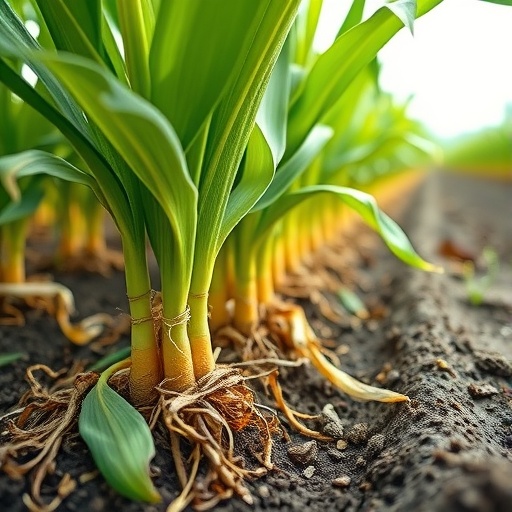In recent years, the imperative to enhance crop resilience under escalating environmental stresses has driven agricultural scientists to delve deeper into the genetic and phenotypic underpinnings of plant root systems. Maize, as a cornerstone of global food security, presents a complex challenge due to the subterranean nature of its roots, which are notoriously difficult to study using conventional methods. Addressing this, a groundbreaking experimental study led by Dior R. Kelley and colleagues at Iowa State University leverages an innovative high-throughput phenotyping platform that integrates advanced image analysis with transcriptomic profiling, providing an unprecedented holistic view of maize root architecture and its genetic regulation.
Traditional root phenotyping approaches such as rhizoboxes and towel assays, though informative, are deliberate and constrained by time, cost, and labor-intensive requirements. These limitations have historically hampered large-scale analyses, especially under field conditions where environmental heterogeneity further complicates measurements. The novel pipeline developed by Kelley’s team integrates open-source software tools—including RootPainter for precise image segmentation, ImageJ/Fiji for meticulous image refinement, and RhizoVision for comprehensive root trait extraction—to enable scalable and reproducible analysis of complex root systems from field-grown maize specimens.
The study encompassed 271 images derived from 22 distinct maize inbred lines cultivated in open field conditions. Through this integrative approach, researchers identified 56 quantifiable root traits spanning morphological dimensions such as root length, branching density, and diameter categories. A critical methodological advance was the implementation of diameter thresholding to discriminate non-root stem tissues, thereby enhancing the accuracy of trait extraction specifically related to root structures. The resultant phenotypic dataset revealed extensive variation among genotypes, with one inbred, W153R, exhibiting notably divergent root morphological characteristics compared to the widely used reference line B73.
Understanding the relationship between early developmental root traits and mature plant architecture remains a pivotal question for crop improvement strategies. By comparing primary root lengths from 10-day-old seedlings against adult root traits across 15 genotypes, the researchers discovered that only a subset of genotypes exhibited weak to moderate correlations, highlighting substantial genotype-dependent developmental plasticity. This finding underscores the necessity of genotype-focused analysis when considering early root trait predictive capacity for breeding programs targeting root system optimization.
Complementing phenotypic investigations, the research team conducted transcriptome-wide expression profiling of 11 inbred lines. This revealed thousands of differentially expressed genes (DEGs), the vast majority of which were genotype-specific, reflecting the intricate and unique transcriptional landscapes underpinning root development. Shared gene ontology (GO) enrichment analyses across DEGs prominently implicated hormone signaling pathways, stress response mechanisms, and cell wall remodeling processes, with particular emphasis on auxin metabolism and β-1,3-glucan biosynthesis pathways—both integral to root growth dynamics and environmental adaptability.
Further dissecting gene expression data, Weighted Gene Co-expression Network Analysis (WGCNA) identified distinct gene modules correlated with specific root traits and genotypic backgrounds. The ‘grey60’ module was notably enriched for genes associated with glucan synthase complexes, essential components for cell wall structuring and modification. Meanwhile, the ‘cyan’ module comprised genes implicated in metabolic regulation and stress response pathways, potentially linking physiological adaptability to root morphology variations. These gene networks provide a robust molecular framework for elucidating the genetic control of root architectural traits.
The integration of automated, high-throughput phenotyping with transcriptomic insights represents a significant leap forward in root system biology, offering scalable methodologies for breeders and molecular biologists alike. By facilitating efficient and reproducible root trait quantification in situ, this approach circumvents traditional bottlenecks associated with underground phenotyping, empowering large-scale genetic association studies that can accelerate crop improvement pipelines. Importantly, this framework affords the resolution necessary to dissect complex genotype-environment interactions affecting root development.
The study’s revelations about auxin-mediated signaling and cell wall modification genes as potential breeding targets hold profound implications for enhancing key agronomic traits such as drought resistance and nutrient uptake efficiency. Auxin, a central hormone regulating root cell elongation and differentiation, alongside dynamic cell wall remodeling enzymes, orchestrates adaptive root growth responses. Manipulating these pathways through targeted breeding or biotechnological approaches promises to refine root systems optimized for fluctuating environmental conditions indicative of climate change.
Moreover, the pipeline’s compatibility with open-source tools ensures accessibility and cost-effectiveness, critical factors for widespread adoption in diverse research and breeding settings globally. This democratization of advanced phenotyping technology can catalyze collaborative efforts, data sharing, and integrative omics studies, ultimately fostering innovations in crop resilience and productivity. As agricultural challenges mount, such scalable solutions will be indispensable for safeguarding food production systems worldwide.
This research not only exemplifies the power of combining cutting-edge imaging and molecular techniques but also charts a roadmap toward unlocking the full genetic potential of maize roots. By correlating morphological diversity with differential gene expression profiles, the study deepens our comprehension of root system complexity and plasticity, offering empirical foundations for breeding programs that prioritize root traits alongside aboveground phenotypes.
In sum, the convergence of automated image-based phenotyping and transcriptome analysis exemplified in this study heralds a new era in crop biology research. It highlights the critical need for multi-dimensional approaches that capture both phenotypic complexity and molecular nuance, paving the way for enhanced root trait selection and improved crop resilience. As global climate variability continues to challenge agricultural sustainability, such integrative frameworks become more crucial than ever, empowering the engineering of robust, climate-adapted maize cultivars capable of thriving in diverse agroecological landscapes.
Subject of Research: Not applicable
Article Title: Identification of phenotypic and transcriptomic signatures underpinning maize crown root systems
News Publication Date: 20-Mar-2025
Web References: http://dx.doi.org/10.1016/j.plaphe.2025.100008
References: DOI 10.1016/j.plaphe.2025.100008
Keywords: Agriculture, Biomedical engineering, Applied mathematics




